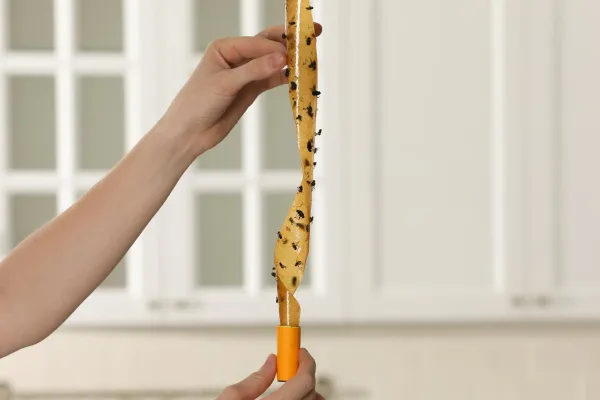
BLOGS
BLOG

Why Are Flies Worse in Spring? Understanding Their Life Cycle
As the chill of winter fades and warmer temperatures return, many homeowners are eager to open their windows, enjoy the fresh air, and embrace the change in seasons. But with spring’s arrival also comes an increase in an unwelcome and frustrating problem: flies. Whether it’s house flies buzzing in the kitchen, fruit flies swarming over the fruit bowl, or tiny drain flies emerging from your sink, spring often marks the start of a seasonal surge in fly activity inside the home.
So why exactly do flies seem to be worse in spring? The answer lies in a combination of environmental conditions and biological processes, specifically tied to the life cycle of these persistent pests.
The Fly Life Cycle: A Springtime Accelerator
Flies undergo what’s known as complete metamorphosis. Their life cycle includes four distinct stages: egg, larva (commonly referred to as maggots), pupa, and adult. In the cold of winter, development slows dramatically or even halts altogether, particularly for flies that overwinter as pupae or adults in protected areas like wall voids, attics, or basements. But once temperatures rise—typically around 65°F to 75°F—flies emerge from their dormant states and rapidly complete their development.
In ideal springtime conditions, the entire life cycle of a fly—from egg to adult—can take as little as 7 to 10 days. This incredibly fast turnaround means that a single fly can lay hundreds of eggs and have several generations in just a few weeks. When you consider that each generation can lay hundreds more eggs, it’s easy to see how quickly a minor problem can become a full-blown infestation.
Spring also brings increased access to food sources. As homeowners begin outdoor projects, barbecues, and spring cleaning, the presence of organic waste increases—an irresistible invitation for flies. Open garbage cans, leftover pet food, compost piles, and even damp mops can all provide the ideal environment for flies to feed and reproduce.
Common Springtime Flies in Homes
While most people refer to them simply as “flies,” there are actually several different types that tend to appear more frequently in spring, each with its own habits and preferred breeding grounds.
House flies are among the most common and easily recognized. These grayish insects are typically found near food sources, especially garbage or exposed leftovers.
Fruit flies are much smaller and are often seen hovering near ripening or decaying fruit, sugary liquids, or even empty wine glasses.
Drain flies, sometimes called moth flies, are fuzzy, slow-moving pests that thrive in the organic matter that builds up in household drains.
Cluster flies—larger, slower flies that often overwinter in wall voids or attics and emerge in spring seeking light and warmth.
Although these flies vary in appearance and behavior, they all share one thing in common: they reproduce quickly and can be difficult to control once they’ve established themselves in your home.
Why Spring Conditions Are Ideal for Flies
Several environmental changes that happen in spring contribute to the spike in fly activity. First and foremost, warmer temperatures speed up the biological processes in flies, making them more active and shortening their reproductive cycles. Unlike mammals, flies are cold-blooded, so their internal temperature depends on the environment. Spring warmth effectively “wakes them up” and puts them into high gear.
In addition to heat, spring is usually accompanied by increased humidity and moisture, which many fly species require for successful breeding. Wet soil, clogged gutters, and slow-draining sinks all offer damp conditions that fly love. Spring rains can exacerbate these issues by creating standing water and encouraging mold and bacteria growth, which flies rely on to feed their larvae.
Many homeowners also begin to open their windows more frequently during the spring. Unfortunately, this provides easy access for flies looking for food or shelter. Screens with small holes or gaps around windows and doors can also become entry points for insects eager to escape the outdoors.
What Homeowners Can Do
Dealing with flies starts with a few proactive steps. Keeping a clean home is the first line of defense. Food should be stored in sealed containers, countertops wiped regularly, and trash taken out often. Overripe fruit should be disposed of or refrigerated, and garbage cans should be cleaned routinely.
Drain maintenance is another crucial step. Organic buildup in drains is a breeding haven for drain flies. Pouring boiling water down sinks or using a mild enzyme cleaner can help break down this buildup and prevent larvae from developing.
Moisture control is also key. Address any leaky faucets or pipes, use a dehumidifier in damp areas like basements, and make sure there’s proper ventilation in bathrooms and kitchens. Lastly, inspect screens and weather stripping around doors and windows to ensure there are no easy entry points for flies.
When to Call the Experts
While many homeowners are successful in reducing fly populations through good hygiene and simple DIY methods, persistent or large-scale infestations often require professional help. That’s where Valley Wide Pest Control comes in.
At Valley Wide Pest Control, we understand the frustration that comes with a home overrun by flies. Our team of licensed professionals offers customized pest control plans that target the specific type of fly infestation you're dealing with. We begin with a thorough inspection to identify the source—whether it’s a clogged drain, an unnoticed garbage issue, or a structural vulnerability. Then, using environmentally responsible treatments and integrated pest management techniques, we eliminate the problem at its root.
But we don’t stop there. Valley Wide Pest Control also provides homeowners with actionable advice and long-term prevention strategies to ensure that flies—and other pests—don’t return season after season. Whether you're facing a few annoying visitors or a major infestation, our reliable, friendly team is ready to help restore comfort to your home.
Don’t Let Flies Take Over This Spring
Spring should be a time to enjoy fresh air, blooming gardens, and sunny afternoons—not a constant battle with buzzing, bothersome flies. Understanding the life cycle of flies and the seasonal conditions that favor their growth is the first step to prevention. But when prevention isn’t enough, you don’t have to handle it alone.
Call Valley Wide Pest Control today to schedule a consultation or pest inspection. Let us help you enjoy a fly-free spring—and peace of mind year-round.
© 2024 Valley Wide Pest Control. All rights reserved.

